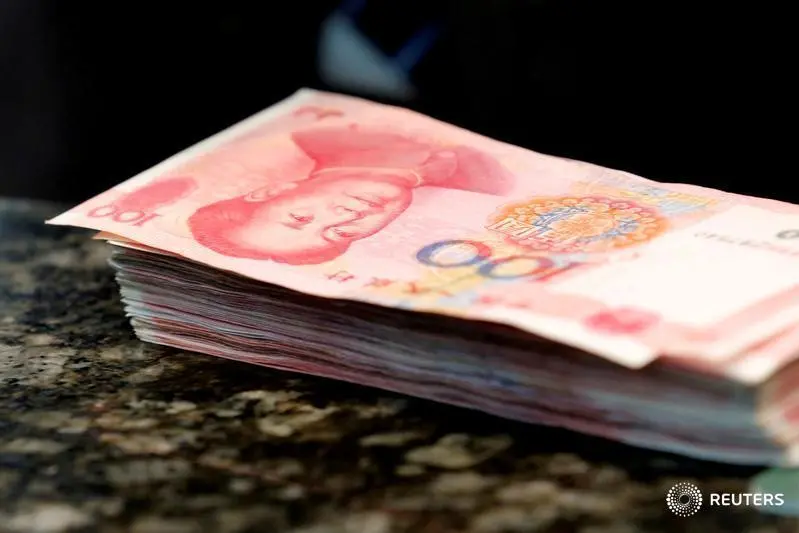PHOTO
(The author is a Reuters Breakingviews columnist. The opinions expressed are his own.)
HONG KONG - Beijing has a golden window to revive its stalled yuan internationalisation process. A recovering economy and rallying renminbi clear the way for reformers to liberalise further, provided conservatives let them.
A heavy reliance on dollars for trade, finance, and for its own reserves leaves the world’s largest exporter overexposed to policies set in Washington. As that diplomatic relationship has frayed, the White House has overtly threatened sanctions requiring Chinese financial institutions to cut ties with blacklisted individuals, including Hong Kong leader Carrie Lam. That would put targeted mainland lenders in the same boat Iranian and North Korean peers are in. Lam is now receiving her salary in cash.
Cue another internationalisation campaign. Zhu Jun, director general of the People’s Bank of China’s international division, told a Shanghai forum in October that the central bank was revamping its strategy given “complications in the domestic and overseas situations.” He mentioned bilateral currency swaps and improving payment settlement processes as areas where the government might provide more policy support.
Investors might be forgiven for yawning; they’ve heard something like this before. Despite a massive diplomatic push to get it included in the International Monetary Fund’s Special Drawing Rights currency basket in 2016, the renminbi – its official title - still comprises only 2% of reserves tracked by the IMF. It’s used for 2% of overseas payments, per data from messaging service provider SWIFT, and that figure includes Hong Kong, which handles three-quarters of that traffic. The bulk of these transactions are probably between onshore and offshore Chinese entities.
So far China’s incremental approach has failed to make a dent. A huge bilateral trade imbalance also restrains progress: running a large surplus sucks yuan back into China, whereas the United States deficit will export its currency. The biggest obstacle, though, has been Beijing’s use of the state-controlled banking system to manage credit and growth.
Letting a currency flow freely across borders is a prerequisite for global status. But mainland policymakers have mixed feelings about that. Surges of outflows have complicated efforts to stimulate domestic investment in the past: between 2014 and 2016, capital outflows drained $1 trillion out of Chinese hard currency reserves. Another concern was the wave of sloppy overseas deals by Chinese conglomerates like HNA and insurer Anbang, which paid top dollar for assets using copious debt, then had to be taken over by officials.
As a result, the PBOC effectively sabotaged its primary offshore yuan market in Hong Kong, intervening in forwards markets and mopping up liquidity. That may have contained yuan outflows and squeezed out currency shorters, but the yuan deposit pool in Hong Kong, at around 680 billion yuan in October ($104 billion), is lower than it was in 2015.
PLUS CA CHANGE Present conditions offer an opportunity to refurbish the currency’s overseas cred. China’s economic recovery has allowed its central bank to hold benchmark interest rates far higher than developed world peers. That has pulled funds into yuan, and between May and mid-December the exchange rate firmed 10% against the dollar. Reassuringly, the rally has yet to hurt China’s exports, and has improved Chinese buying power overseas.
Currencies rise and fall, of course, but recent reforms have positioned the People’s Republic to increase its share of longer-term investments too. Every successful global currency is backed by a deep, liquid and open bond market. China’s is not there yet, but it has made major improvements. A laundry list of regulatory distortions that deterred overseas fund managers has been dramatically shortened. That has seen major index providers, most importantly FTSE’s World Government Bond Index, begin to incorporate Chinese sovereigns in their benchmarks. Foreign investors now hold 10% of the government market, and 4% of the total. A Breakingviews analysis shows foreign holdings totalled around 3.2 trillion yuan ($490 billion) in November.
Moreover, the government is looking to expand outbound investment. That will include $10 billion in fresh quota for the Qualified Domestic Institutional Investor scheme that channels Chinese money into offshore stocks and bonds. It has also started rolling out a digital currency. A traceable renminbi could theoretically allow the PBOC to relax a bit about capital outflows; overseas purchases using virtual yuan would be easier to monitor, control and even reverse, so restrictions could be more targeted. A blockchain-style currency technology could also evade White House sanctions via the SWIFT payment messaging system. Even Hong Kong’s once-mordant renminbi-denominated “dim sum” market has enjoyed a mild revival in policy support.
The question is how much further Beijing will go to open up its capital accounts. Foreign trust in China’s commitment to selective market reforms has increased, and fund managers are rebalancing portfolios into mainland assets. The central bank expects foreign holdings of domestic bonds to eventually reach 15% of the total market. That’s fine, but unambitious. Incremental reforms will yield incremental increases in the yuan’s importance, but not enough to change the fundamental dollar-dominated dynamic.
(The author is a Reuters Breakingviews columnist. The opinions expressed are his own.)
(Editing by Robyn Mak and Sharon Lam) ((pete.sweeney@thomsonreuters.com; Reuters Messaging: pete.sweeney.thomsonreuters.com@reuters.net))












